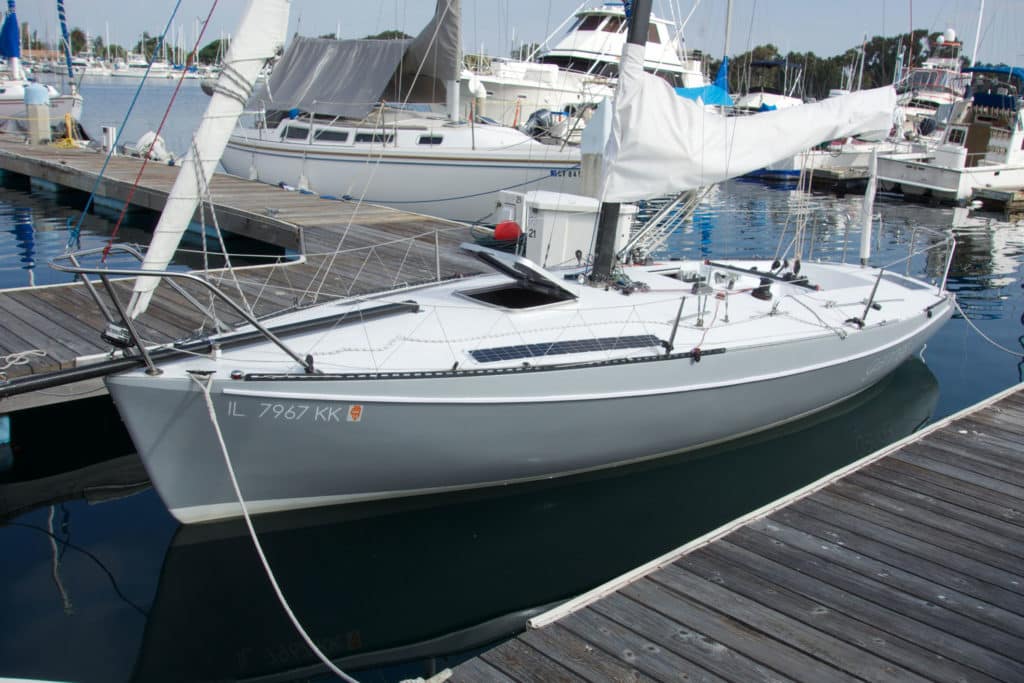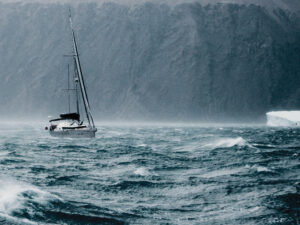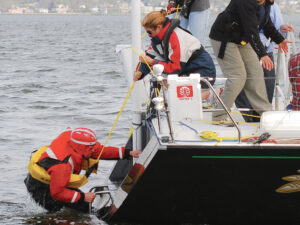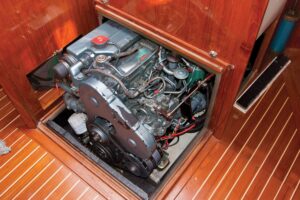
Moore 24 Gannet
With an interior aboard my Moore 24 that I could live in and with, I moved to the deck where I considered anchoring and sail handling. Boats, particularly small boats, are filled with compromises. Gannet came with a “toy” anchor and 150-feet of polyurethane rode that I assume met some race requirement, but were far from adequate in the real world.
I prefer to anchor on all chain, which is too heavy for a Moore 24, and to use anchors without pivot points, which are potential finger pinchers. My previous boat, The Hawke of Tuonela, had three 33-pound Bruce anchors, a 35-pound Delta and a 20-pound aluminum Spade. For a decade the Spade was my anchor. However, the correct Spade for Gannet weighs 10 pounds and costs more than $400. I may buy one eventually, but for now I settled on a 14-pound Delta costing $105 at an end-of-season sale and matched it with a 230-foot rode of ½-inch, 8-strand plait with 20-feet of ¼-inch chain. I also bought the smallest bow roller I could find, and replaced the U-bolts for bow lines with cleats. The rode is oversized for Gannet, which is a compromise I can live with.
Working at the bow brought me in contact with Gannet‘s lifelines. Not all Moore 24s even have lifelines, but I decided to keep the boat’s low ones, more as something to hold onto than to prevent falling overboard. I did replace the wire with AmSteel line, which is stronger, lighter and easier on skin.
Gannet‘s headsails had hanks, the first I’d used in decades, and her mainsail a boltrope. When lowered, they flew all over the place. I tamed the jib by having Furlex furling gear installed and, later, corralled the main by having a new, fully battened one built that’s raised and lowered on a Tides Marine Strong System track.
I also bought a new 110-percent furling jib and an asymmetrical spinnaker to be set with Facnor gennaker furling gear.
All this duplicates what I used successfully on The Hawke during my fifth circumnavigation. Gannet‘s new sails are not as fast as her former racing sails, but being able to control them quickly from the cockpit is, to me, worth the modest loss in performance.
Gannet is the only Moore 24 I have ever seen, but other Moore owners have provided me with useful information by email. After seeing photos of Gannet‘s interior online, one wrote to tell me that she is the only Moore he knows of that does not have below-deck reinforcement for the aft lower shroud. Usually this is done by having pad eyes back to back – one above deck, one below, secured by the same bolts – with a wire or high-tech line run from the below deck eye to a turnbuckle attached to a third pad eye secured down low on a partial bulkhead. He even sent some photos that showed the arrangement on his boat.
I must admit that I had wondered about Gannet‘s aft lowers, and the fact they weren’t attached to a chainplate, but being inexperienced with the stresses on a Moore 24 rig, I thought it was normal.
After rewiring the autopilot deck fitting, my two main projects in the spring of 2012 were to secure the aft lower shroud and to install solar panels. A question online at the Moore 24 owner’s group about upgrading winches added another job when I decided to follow a suggestion and replace the old Barient 10s with Harken 20.2s, which are dramatically bigger but weigh less than a half pound more apiece.
The only difficult part in reinforcing Gannet‘s aft lowers was removing the U-bolts, the deck fittings that needed replacement. When I was finally able to pound them up with a hammer and connect the necessary pad eyes, turnbuckles and Amsteel line, it all went smoothly.
The new Harkens arrived while I was working on the shrouds. After consulting the owner’s manuals, I noted that Harken specifies either slot head or hex head M6 bolts for installation. I am used to the metric system, which has been adopted by every country except the United States, Myanmar and Liberia (now there’s a set of allies for you). But, understandably, my small local WEST Marine store did not carry metric bolts, so I bought ¼-inch hex heads instead.
After drilling holes through the deck, I discovered that Harken means what they say: They didn’t work. So I ordered M6s online. When they arrived, they fit the winches perfectly. Sometimes it pays to do what you’re told.
Often when I was working on Gannet, I studied her deck, considering the placement of the solar panels. I had narrowed my choices to panels by Aurinco and Ganz, and made full-size cardboard cutouts of various sizes and took them up to little boat.
The difference between a 18 ½-inch x 16 ¼-inch rectangle, and one measuring 22 ⅛-inch x 20 ½-inch does not seem great but, as the cutouts revealed, on Gannet‘s deck the discrepancy is critical.
The larger Ganz 30 watt panel was too big, so I ordered two of the smaller Aurinco 25-watt panels for placement near the stern, and two larger 47 ½-inch x 6-inch Aurinco 25 watt panels to mount somewhere forward. I also ordered a Blue Sky Solar Boost 2000e regulator, which I’d found effective on The Hawke. When the panels arrived I was impressed by their construction and finish. Only 1/8th of an inch thick, they won’t stub toes and are flexible enough to follow the slight camber of Gannet‘s deck.
Positioning solar panels is another challenge. They need to avoid shadows and be out of the way, yet also be aesthetically pleasing. Because of the latter requirement, I eschewed mounting them on pulpits or towers (and also decided against a wind generator, which would easily produce more power than Gannet‘s needs at less expense).
The placement of the two at the stern was obvious within an inch or two. They’re in the way when I lower or raise the Torqeedo, so at such times I put a cushion over the panel to protect it. Aurinco says the panels can be walked on, but it is better not to.
One night when I slept on the boat, I moved the two forward panels around frequently, finally leaving them a few inches to either side of the forward hatch running forward, parallel to the centerline. Just before drilling holes the next morning, I decided they were in the way there and moved them outboard. Depending on wind angles, the sun and the heading, at times they will be shadowed by the sails. Only time will tell if the four panels are sufficient for Gannet‘s needs.
By the time all that was done, spring had given way to summer, a third of which was gone. I was tired of working. It was time to put down the tools and go sailing.








